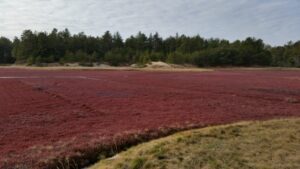Why cranberry country is turning into wetlands
Massachusetts farmers began draining wetlands to make cranberry bogs more than two centuries ago. Now there’s a race to restore them.

As the sun set on a November afternoon, Brendan Annett walked through a wetland preserve, greeting everyone who passed him by with the enthusiasm of a mayor at a ribbon cutting.
Which he kind of was. Annett, who oversees conservation projects for the nonprofit Buzzards Bay Coalition, had recently finished work on the site known as Mattapoisett Bogs that, for more than a century, had been a working cranberry farm. As the industry waned here, the family who owned the land had sold it to the conservation group, which had set about transforming it back to the wetland it once was. Walking trails had just reopened to the public. But as ducks paddled in placid water and late-afternoon light turned the reeds and rushes to gold, it was easy to imagine it had been this way forever.
Continue reading on The Washington Post.
Negotiations at COP29 in Baku, Azerbaijan ran well past the scheduled end of the conference Friday evening. While the final outcomes fell short of hopes, they exceeded many expectations.
And while a full analysis of the final decisions will take time, a few key takeaways are already clear. The new goal for climate finance is an important step in the right direction, but responsibilities for it are ambiguous. The same can be said for the global goal on adaptation, conclusions about the need for enhanced research and observation systems, and a work plan for greater involvement of Indigenous peoples in the UN climate negotiation process. There was some enhanced clarity around mechanisms for implementing carbon markets under Article 6 of the Paris Agreement; however, the failure to reach consensus on the Just Transition Work Programme and improvements to the Global Stocktake process used to gauge progress toward climate goals were distinct disappointments.
Every COP presents unique challenges and opportunities, the pace of diplomacy rarely matches the acceleration of climate change, and under the Paris Agreement, the responsibility for ambition lies at the national level. But the main negotiations—as important as they are—are not the only venue where progress is made. Over the course of the two week convening, Woodwell Climate’s delegation hosted and participated in dozens of meetings and events, scoring significant wins at COP29:
- The UNFCCC announced a collaboration with Woodwell Climate to develop a new training course to prepare experts for a voluntary review of adaptation reporting by Parties under the Paris Agreement. This will be an important support for understanding the global state of readiness for climate impacts.
- We responded to an agreement regarding principles for implementing carbon markets under the Paris Agreement, calling on negotiators to center the voices of developing nations and Indigenous peoples, and move from aspiration to operation to ensure just, credible, and effective carbon markets. The final decision on Article 6 moves in this direction, and calls for expedited work on further specifications, supported by scientific and technical expertise.
- Building on our previous work with partners in the Ethiopian capital of Addis Ababa, we presented a nationwide climate risk assessment for Ethiopia that provides valuable information for the development of resilience strategies and contributes to the UNFCCC’s work on the global goal on adaptation.
- We discussed the potential for AI to empower climate action on a panel hosted by Google.org in the UNFCCC pavilion.
- We welcomed Senator Ed Markey to the Woodwell Climate pavilion. Sen. Markey has championed multiple pieces of legislation informed by Woodwell Climate science, most recently a bill to make permafrost a weather forecasting priority.
- In partnership with the Environmental and Energy Study Institute, we put the growing challenge of carbon pollution from wildfires on the official program with the only COP29 side event on the topic. The panel discussion highlighted the latest science and made the case for greater ambition in the next round of national climate commitments to account for this increasing emissions from natural sources.
- Brazil, the host of next year’s COP, released their new climate pledge—one of the first nations to do so. Woodwell Climate scientists provided significant consultation on the plan, which prominently features ecosystem conservation, climate justice, and sustainable development, as well as science-based decision making and a new mechanism to finance forest protection.
As is always the case, this COP was the first step on the road to the next one. COP30 will bring the UN climate change negotiation process back to Brazil, where the UN Framework Convention on Climate Change was adopted in 1992, and where sustainable food production and tropical forest conservation—core areas of research and expertise for Woodwell Climate—are expected to be at the top of the agenda.
What the Earth’s recent heat uptick could mean for the climate fight
And why one climate scientist still has reasons to hope.

Scientists monitoring Earth’s climate have identified a concerning trend in global warming starting in April 2023. While climate change has been steadily heating up the planet for decades, in 2023 global average temperatures suddenly jumped by about 0.2 degrees Celsius and have remained elevated.
The spike in temperature has raised alarm among climate scientists about how fast the climate crisis is progressing as they scramble to explain Earth’s worsening fever.
Jennifer Francis studies climate and weather in the Arctic at the Woodwell Climate Research Center and has had her eyes on the planet’s rising temperature for decades.
Read more on Inside Climate News.
Dr. Matti Goldberg, the Director of International Government Relations at Woodwell Climate, explains the stakes of COP29 from Baku, Azerbaijan.
This year, Las Vegas, Nevada broke its all-time heat record, reaching 120° F.
The temperature was recorded at Harry Reid International Airport on July 7, 2024. That week, between July 6 and July 12, was the new hottest 7-day period on record, with an average high temperature of 117.5° F.
This is the daily reality for Vegas residents in the summer. Record-breaking temperatures are hard to bear, but so were all the hot days and nights that came before. Commuters frequently see temperatures above 120 flash on their vehicle dashboards, and outdoor workers struggle to do their daily tasks under the hot sun.
“There’s a disconnect between climate science and the people who live here,” says Woodwell Climate Research Associate, Monica Caparas. “Vegas residents know our summers are hot and unbearable. Understanding climate change is driving the extreme weather we’re experiencing is where the disconnect lies. ”
Caparas moved to Las Vegas as a child. She grew up there, left for college, and returned to settle into her adult life. Today, she works for Woodwell Climate’s Risk team remotely from her home in the city. Caparas knows the ins and outs of local life. These include Vegas’s rapid population expansion, the groups of people experiencing homelessness sheltering in underground stormwater infrastructure, and the heat that was unbearable before it started making headlines.
Experiencing climate change without shelter
Caparas’s work with the Risk team aims to provide communities like Las Vegas with an accurate picture of the climate-driven changes in their future. These “risk assessments” are provided through Woodwell Climate’s Just Access program, which uses the most accurate climate models, in collaboration with local knowledge, to anticipate future community safety threats. The analyses have brought to light growing threats from flooding, heat, storms, and more. The team provides assessments, free of charge, to states, cities, and countries across the world.
Just Access serves what Risk Program Director Christopher Schwalm calls “frontline communities.” The term describes groups of people who are over-exposed, under-resourced, underserved, historically marginalized, and therefore the most at-risk to the repercussions of climate change. In the risk assessment for Las Vegas, people experiencing homelessness are front and center.
“Between May 20th and the first week in July, about 20 people who were experiencing homelessness died of heat,” says Dr. Catrina Grigsby-Thedford, Executive Director of the Nevada Homeless Alliance (NHA) and community partner in Las Vegas.
The NHA estimates that almost 8,000 people are experiencing homelessness on any given night in southern Nevada. The number is only growing. Grigsby-Thedford says that this year’s unhoused population is up 1,300 people compared to 2023.
“Often our shelters are full,” Grigsby-Thedford says, “We’re limited by shelter beds and space.”
The NHA’s shelters do open all day in extreme heat, but so many people packed tightly together is still unsafe.
With nowhere to go, some seek shelter underground in Las Vegas’s stormwater infrastructure. While the tunnels are cooler out of the sun’s reach, they are at risk from flooding. Across the region, extreme precipitation is expected to increase by 12-14% by 2050, raising flood risk in the city and especially within the tunnels.
To combat lack of space and shelter, the NHA hosts 4-8 one-stop resource fairs per month. The events, called Project Homeless Connect, serve both people experiencing homelessness and low-income residents in Las Vegas. Grigsby-Thedford says these events “fill in gaps”—offering housing assistance, medical care, hygiene care, and other resources.
Despite all of this work, many unhoused people are hesitant to engage with organizations like the NHA. Grigsby-Thedford says “choice is often a challenge,” and that when people grow accustomed to the way things are, they often accept it and choose to stay.
Picturing risk
Building trust with communities, especially those predisposed to mistrust outside actors, is essential in this work. Which is why, Schwalm says, Woodwell Climate approaches risk work with the goal of “meet[ing] people where they are.”
That means “scoping,” the team’s word for listening to what community and government leaders want out of the risk analysis—what concerns they have, weak points they’ve identified, and what help might be needed post-analysis.
“Two-thirds of the time we spend from start to finish falls into this scoping idea, rather than doing analysis itself,” Schwalm says.
Scoping frames the data the risk team collects, as well as who their partners will be during the risk analysis process.
“We find people who are practical and recognize that there’s a problem,” Schwalm says, “We only work with communities who want to work with us.”
Following the scoping process, the Risk team compiles an analysis of extreme weather events and subsequent risks each community will face as climate change progresses.
“We perform a stress test of that particular geography to identify weak points,” Schwalm explains.
Then, the Risk team uses the most up-to-date climate models possible to predict changes in extreme weather and regional climate. By using predictive models, the team focuses efforts on what the future will hold, as opposed to using past strategies.
“We need to use the future to predict the future,” Schwalm says simply.
Making climate risk data accessible to all
Over the past three years, Just Access has provided 50 communities—that’s about a quarter billion people—with risk analyses. These communities span the U.S., Central and South America, Africa, Asia, and Oceania. They’ve worked with countries, like the Democratic Republic of Congo, where they helped update the country’s National Adaptive Plan, states like Chiapas in Mexico, groups like Cree Nation in Canada, and other communities, now including Las Vegas.
Despite all of this work, though, Schwalm says there is still room to grow.
“Fifty communities is kind of only a drop in the bucket,” he says, “We’re not going to make a huge dent in this unless we move beyond working community-by-community.”
Two major roadblocks for Just Access are finite resources: time and money. Individual risk analyses require a lot of time and communication to address risks in relatively small areas.
The other obstacle, money, is something climate research could always use more of. Grants and donations are crucial in order for analyses to remain free, and those sometimes come with limitations.
“There’s a tension from the funder to work in a specific geography sometimes,” Schwalm says, “It’s a juggling act.”
Climate change can also be a politicized topic. In order to meet people where they are, sometimes the Risk team implements changes in language used to communicate with community leaders. This can be a change as simple as using “extreme weather” instead of “climate change.” As long as everyone in the room is ready to confront what the future holds, they’re all working on the same page towards the same goal.
“We’ve done red states, blue states, rural, urban,” Schwalm continues. “We’ve learned how to read the room.”
Creating the foundations for change
Woodwell Climate’s involvement in Las Vegas brings to light the way justice issues, like homelessness, interact with growing threats from climate change.
“In the Las Vegas risk assessment, we are focusing on the disproportionate impacts of the climate crisis on communities already facing systemic socio-economic inequity,” says Caparas. “We must think about intersectionality in order to address climate justice.”
Not only does climate change represent a current crisis for those experiencing homelessness, communities with fewer resources are now at greater risk of being made homeless by future climate-related disasters. Accurate climate risk information can support organizations like NHA as they develop strategies to serve people experiencing homelessness in a more extreme future.
Grigsby-Thedford says that NHA members, especially those with lived experience of homelessness who work as Lived X Consultants, are always looking to be involved in projects like the one Caparas leads.
“We always talk about weather in our meetings,” she says, “So this is perfect, someone’s actually doing research about this. Anything that impacts [Las Vegas’s homeless population], we want to make sure we’re involved in that.”
For the Las Vegas risk assessment, Caparas is working with the NHA and Southern Nevada Lived X Consultants to understand climate risks around cooling stations in public buildings, which are a vital, air-conditioned shelter when the heat index is too high. Grigsby-Thedford says there were many more cooling stations in 2023 and 2024 compared to previous years.
Caparas also forged a connection with Miguel Dávila Uzcátegui, Southern Nevada’s Regional Transportation Commission (RTC) Senior Planner and board member of Help Hope Home. Together, they are developing a database of flooding infrastructure and updating the city’s flooding model with future climate projections. The RTC will integrate the Risk team’s model into regional planning work, updating Las Vegas’s flooding and transportation infrastructure for community safety.
None of this work would have been possible without Caparas’s diligent bridge building between the scientific resources of Woodwell Climate and the needs of people in her own community. Those connections allow science to be informed first and foremost by those most affected by climate change.
“The people closest to the problem are the people closest to the solution,” says Grigsby-Thedford.
It’s already official: You’re living through the hottest year on record
According to the European Union’s climate agency, 2024 is also the first year to breach a key climate threshold.

Nine months ago, the oceans became bathwater. As historically hot sea temperatures forced corals to expel the microorganisms that keep them alive, the world endured its fourth mass coral bleaching event, affecting more than half of all coral reefs in dozens of countries. As the temperatures continued to climb, many died.
It was an early taste of what would become a year marked by the consequences of record-breaking heat. And now it’s official: Last week, when much of the world’s attention was turned to the U.S. presidential election, scientists from the European Union’s Copernicus Climate Change Service crowned 2024 as the hottest year on record — and the first year to surpass the 1.5 degrees Celsius benchmark. And that’s with two months left to go in the year.
Woodwell Climate Research Center and UN Climate Change are collaborating to develop a new training course—announced November 14 at COP29 in Azerbaijan—to prepare experts for a voluntary review of adaptation reporting by Parties under the Paris Agreement.
Countries submit Biennial Transparency Reports (BTRs) every two years to inform the world about their national climate efforts. These reports are vital enabling tools for governments, helping to build a robust evidence base critical to strengthening climate policies and climate action over time. The first BTRs are due at the end of 2024.
“Transparency is a priority for the COP29 presidency, because transparency is a cornerstone of climate action,” said a representative for the COP29 presidency at the Together for Transparency event on Thursday.
Each BTR will be reviewed by teams of technical experts coordinated by UN Climate Change, which provides a set of training courses for experts to prepare for that task. A country can request a voluntary review of the information it has reported on adaptation efforts, which requires special expertise on climate risk and adaptation to execute.
This collaboration draws on Woodwell expertise on climate change impacts and adaptation reporting, as well as climate risk and vulnerability assessments. Woodwell Climate’s Director of International Government Relations, Dr. Matti Goldberg, was responsible for spearheading this collaborative effort.
The training will encompass a set of five lessons and accompanying exams that help future expert reviewers learn key aspects of vulnerability assessments, adaptation planning, monitoring and evaluation, and loss and damage, among other issues. These lessons will be launched in a PDF downloadable format by the end of 2024.




